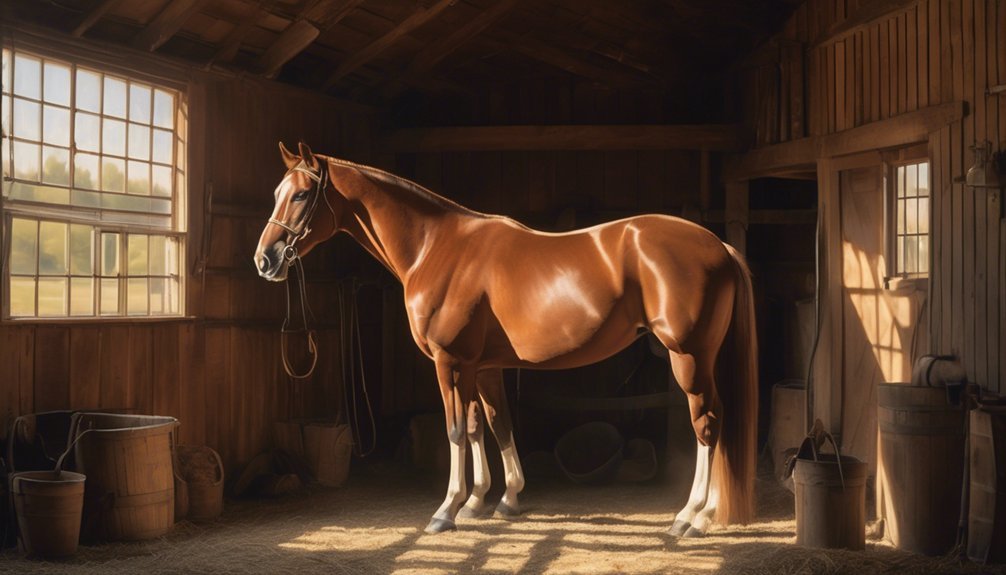
Training your horse to enjoy grooming involves understanding their behavior and creating a positive experience. By establishing a calm environment and using gentle techniques, you can foster trust and comfort. It's important to introduce grooming tools gradually, ensuring your horse feels safe. With the right approach, grooming can transform from a routine task into a rewarding bonding experience. But how do you effectively implement these strategies without overwhelming your horse?
Key Takeaways
- Observe your horse's body language to identify stress signals, and approach gently to build trust and comfort.
- Create a calm grooming environment with soothing scents, soft music, and a distraction-free space.
- Use positive reinforcement by rewarding your horse with treats or praise during grooming to create a positive association.
- Gradually introduce grooming tools, allowing your horse to sniff them first and starting with less sensitive areas.
- Establish a consistent grooming routine that aligns with your horse's preferences, focusing on their favorite spots for added enjoyment.
Understanding Your Horse's Behavior

Understanding your horse's behavior is crucial for creating a positive grooming experience. Pay close attention to your horse's body language; it tells you a lot about how they're feeling. Signs like pinned ears or a tense tail can indicate stress signals, suggesting your horse isn't comfortable.
When you notice these cues, pause and assess the situation. Approach your horse gently, allowing them to become accustomed to your presence. Offering soft words and gentle touches can help establish trust.
Establishing a Calm Environment
Creating a calm environment is essential for your horse to feel comfortable during grooming sessions. Start by selecting a quiet grooming space, free from distractions and sudden noises.
Ensure the area is well-lit and has a comfortable temperature, as your horse will be more relaxed in a pleasant setting. Consider incorporating calming scents, such as lavender or chamomile, which can help soothe your horse's nerves.
You might also play soft music or nature sounds to create a serene atmosphere. Spend a few moments with your horse before grooming, allowing them to acclimate to the space.
Using Positive Reinforcement Techniques

When you incorporate positive reinforcement techniques into grooming, you not only enhance your horse's experience but also strengthen your bond.
By using reward systems, you tap into equine psychology, encouraging your horse to associate grooming with positive outcomes. Start by offering treats or praise during and after grooming sessions. This creates a pleasurable environment, allowing your horse to feel safe and valued.
Keep your rewards consistent; this clarity helps your horse understand what behaviors are encouraged. Gradually, your horse will look forward to grooming, recognizing it as a time of connection and care.
Gradual Desensitization to Grooming Tools
To help your horse feel comfortable with grooming tools, start by introducing them slowly and patiently.
Begin with gentle grooming tool selection, choosing softer brushes or sponges that won't overwhelm your horse. Show the tool to your horse, allowing them to sniff and investigate it before any contact.
During the desensitization process, use calm, soothing words to reassure your horse. Gradually introduce the tool to their body, starting in less sensitive areas, like the neck or shoulder.
If your horse shows signs of discomfort, take a step back and give them space. Celebrate small victories, and remember, this process takes time.
Building trust is essential, so maintain a loving approach throughout your journey together.
Building a Consistent Grooming Routine

After your horse has become comfortable with grooming tools through gradual desensitization, establishing a consistent grooming routine can further enhance their enjoyment and trust.
Start by creating a grooming schedule that fits both your needs and your horse's preferences. Consistency builds familiarity, so choose specific times for grooming, whether it's daily or several times a week.
Pay attention to your horse's reactions; they'll let you know what they enjoy most. Some horses may prefer a gentle brush over a firmer one, or they might love a particular spot being scratched.
Frequently Asked Questions
How Often Should I Groom My Horse?
You should groom your horse daily for optimal health and bonding. Daily grooming enhances circulation, helps you spot issues early, and strengthens your relationship, making your horse more comfortable and receptive to care and handling.
What Tools Are Best for Sensitive-Skinned Horses?
So, you think every brush is a magic wand, huh? For sensitive-skinned horses, you'll want soft, sensitive brushes and natural remedies like coconut oil. These tools soothe, ensuring grooming's a gentle, loving experience for both of you.
Can Grooming Help With My Horse's Anxiety?
Grooming does help with your horse's anxiety. The soothing touch not only builds trust but also promotes relaxation, leading to significant grooming benefits. Regular grooming sessions can effectively reduce anxiety, enhancing your bond with your horse.
Should I Groom My Horse Before or After Riding?
Grooming your horse before riding creates a bond, enhancing trust and relaxation. It prepares both of you mentally and physically, while also providing grooming benefits like improved circulation. After riding, it reinforces your connection, promoting a sense of calm.
How Do I Know if My Horse Enjoys Grooming?
To know if your horse enjoys grooming, observe their body language cues. Look for relaxed ears, soft eyes, or leaning into your touch. Pay attention to their grooming preferences; these signals reveal their comfort and happiness.
Conclusion
Grooming your horse can be a beautiful dance of trust and connection. By understanding your horse's behavior and creating a calm environment, you set the stage for this partnership. Incorporating positive reinforcement and gradually introducing grooming tools helps build a sense of comfort and safety. Lastly, a consistent grooming routine turns this practice into a cherished ritual. With patience and empathy, you'll transform grooming from a mere task into a joyful experience for both you and your horse.





